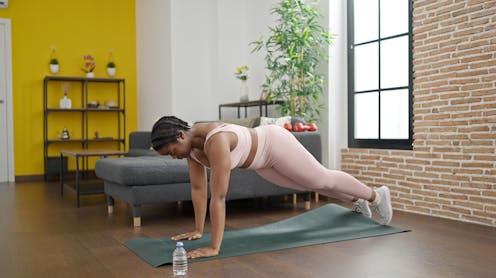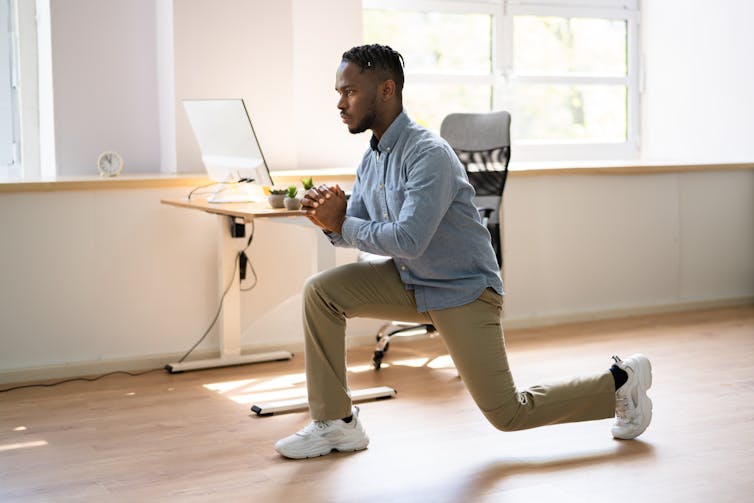
Calisthenics, a workout routine that has existed for centuries, has seen a major resurgence in recent years – partly due to its simplicity and effectiveness. Celebrities including Chris Hemsworth and Jamie Foxx swear by this style of training, which has been used since at least ancient Greek times.
Rooted in movements that resemble gymnastics, typical calisthenics exercises include push-ups, squats and lunges. This training method harnesses gravity and your own bodyweight to build strength, flexibility and endurance. It’s incredibly versatile and can be performed almost anywhere, as you don’t need any equipment.
It’s also extremely beneficial for health and fitness in more ways than you might realise. Here are just a few of the benefits these no-frills bodyweight workouts can have.
1. Boosts core strength
Calisthenics strengthens the deep core muscles in your abdomen and back, which play a crucial role in supporting and stabilising the spine.
By strengthening these deep core muscles, calisthenics improves coordination, which in essence makes your body more resilient and responsive – helping you avoid accidents and injury in your day-to-day tasks. A stronger core helps you maintain better posture and have control of your movements, lowering risk of muscle strains, pulls or missteps when performing everyday activities such as lifting groceries or bending down to pick something up.
Calisthenics exercises such as planks, hollow body holds and mountain climbers are great for targeting the deep core. Performing these exercises as part of a regular workout routine (around 3-4 times a week) will help strengthen your muscles essential for balance, stability and coordination.
2. Better heart health and metabolism
Simple calisthenic exercises, such as squats, arm circles and lunges, can have a big effect on health – especially for people who are sedentary.
One study found that sedentary adults who did calisthenics three times a week for ten weeks saw positive improvements in their blood pressure, resting metabolic rate, heart rate and body fat levels. Such improvements could contribute to better heart health and metabolism in the long run.
3. Builds muscle and strength
Calisthenics is a great way to build serious muscle strength and endurance. This makes it a good workout for young adults, as it may help prevent the natural loss of muscle mass and strength that happens as we enter our 40s and 50s.
Focusing on functional movements that mimic everyday tasks, such as squats and push-ups, can help promote longevity and prevent injuries. Isometric holds such as wall sits or planks can help build muscle and endurance, while dynamic movements such as lunges and squats can help maintain balance and mobility.

Calisthenics is also a great way of breaking up long periods of sitting during the workday. Short bursts of movement will help prevent stiffness, poor circulation and muscle weakening while keeping your metabolism active. It also reduces the risk of issues like back pain, heart disease and diabetes by re-engaging muscles and improving blood flow.
4. Improves motor skills
For children and teens, calisthenics can help them develop coordination, strength, and motor skills. Activities such as running, jumping and climbing, as well as bodyweight exercises such as push-ups and squats, help children build functional strength and agility.
5. Reduces risk of falls
The risk of falls and injury increases with age. But bodyweight exercises that improve stability and coordination can significantly reduce this risk.
Gentle calisthenics exercises help improve joint health, flexibility and muscle tone, which are crucial for staying active and independent. Calisthenics also helps maintain muscle strength and bone density, which are key to preventing frailty and preserving independence in older age.
Chair squats, modified push-ups (on your knees or against a wall), standing leg raises, arm circles and calf raises are all examples of calisthenics exercises that older adults can do.
Calisthenics has also been shown to improve cognition, mood and even sleep disorders in older adults.
How to get started
While calisthenics is a highly effective and accessible workout, it comes with potential risks – particularly when performed incorrectly or without proper preparation.
For beginners, to minimise the risks and maximise the benefits of calsithenics training, here’s what you should do:
Warm-up and stretch: A proper warm-up will prepare the muscles and joints for calisthenics. Dynamic stretching, such as leg or arm swings, will prepare the body for exercise.
Focus on form and progress gradually: Before attempting advanced exercises or increasing the intensity, beginners should focus on mastering the correct form. Start with simple exercises and gradually build strength. For example, begin with wall push-ups before progressing to full push-ups on the floor. Concentrate on good form over the amount of repetitions you do of an exercise. Quality over quantity is key in preventing injury.
Strengthen core and stabilising muscles: Core strength is crucial in calisthenics for maintaining proper posture and preventing injuries. During each workout, aim to include a core exercise, such as planks, to build a stable foundation for other movements.
Watch where you workout: Whether you exercise indoors or outdoors, always make sure you’re performing movements on even, stable surfaces.
Calisthenics can be a highly effective form of exercise for building strength, flexibility and endurance. It’s also low-cost and versatile for people of all ages and fitness levels. Just make sure you aren’t jumping into workouts too quickly, so you can fully appreciate the benefits of calisthenics without injuring yourself.
The authors do not work for, consult, own shares in or receive funding from any company or organisation that would benefit from this article, and have disclosed no relevant affiliations beyond their academic appointment.
This article was originally published on The Conversation. Read the original article.







